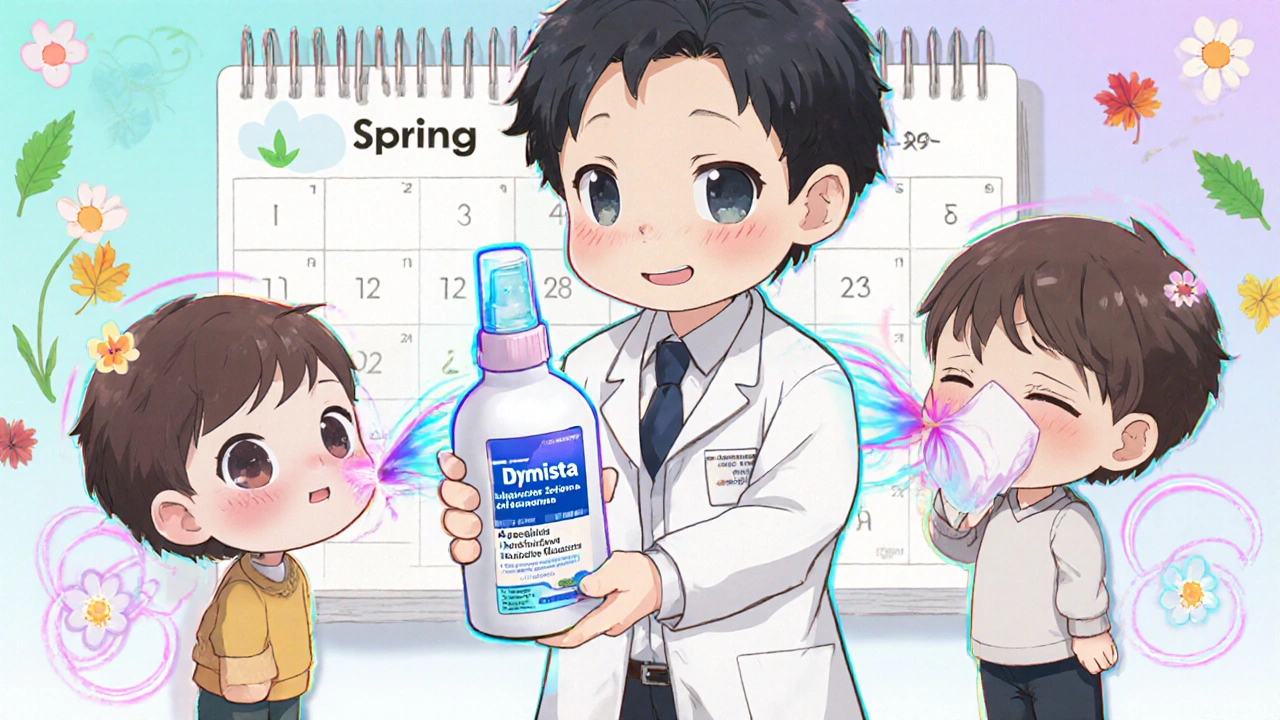Allergy Treatment Selector
Step 1: Your Symptoms
Step 2: Your Preferences
Recommended Treatment
Nasal antihistamine sprays are one of the most underused tools for managing seasonal allergies. If you’ve ever woken up with a dripping nose, constant sneezing, or itchy eyes after stepping outside, you know how disruptive these symptoms can be. Oral antihistamines like Claritin or Zyrtec help, but they often leave you feeling drowsy or dry-mouthed. Nasal sprays like Astepro or Astelin work differently - they target the problem right at the source: your nose.
How Nasal Antihistamine Sprays Work
Allergies happen when your body overreacts to harmless things like pollen, dust, or pet dander. Your immune system releases histamine, a chemical that triggers swelling, itching, and mucus production. That’s why your nose runs, you sneeze, and your eyes water.
Nasal antihistamine sprays contain active ingredients like azelastine or olopatadine. These drugs block histamine receptors in your nasal lining, stopping the allergic response before it spreads. Unlike oral pills that travel through your bloodstream, these sprays act locally. That means faster relief - often within 15 to 30 minutes - and fewer side effects like drowsiness.
The first nasal antihistamine spray, azelastine (brand name Astelin), got FDA approval in 1996. Since then, it’s become a go-to for people who need quick, targeted relief. Astepro, the over-the-counter version of azelastine, hit U.S. shelves in 2014, making it easier and cheaper to access.
What You Can Expect: Benefits
Here’s what most users report after using nasal antihistamine sprays consistently:
- Fast relief - Unlike steroid sprays that take days to work, these sprays start easing symptoms within half an hour.
- Best for runny nose and sneezing - If your main issue is dripping nose or sudden sneezing fits, this is one of the most effective options.
- Less drowsiness - Compared to oral antihistamines, systemic side effects are rare. You’re not likely to feel foggy or tired.
- Works well with other treatments - Doctors often recommend using these sprays alongside nasal steroids like Flonase. Together, they cover more symptoms: steroids reduce swelling, antihistamines stop the runny nose.
- Good for intermittent allergies - If you’re only allergic during spring or fall, you don’t need to use them year-round. Just start when symptoms appear.
Studies show azelastine reduces nasal allergy symptoms by 70-80% compared to placebo. That’s stronger than many oral options for runny nose relief.
Side Effects: What You Might Experience
These sprays aren’t side effect-free. The most common complaints aren’t dangerous, but they’re annoying enough that many people stop using them.
- Bitter taste - This is the #1 complaint. Up to 85% of users who quit say the bitter aftertaste was why. It happens when the spray drips down your throat. The fix? Don’t swallow right after spraying. Drink water, orange juice, or chew gum to mask it.
- Nasal burning or stinging - About 25% of first-time users feel a sharp sting. It usually fades after a few days. Using a saline spray 15 minutes before can help reduce this.
- Nosebleeds - Happens in about 15% of users, especially if you spray too hard or aim at the center of your nose. Always aim the nozzle toward your ear, not straight up.
- Dry nose - Less common, but some users report crustiness or irritation.
Unlike decongestant sprays like Afrin, nasal antihistamines don’t cause rebound congestion. You can use them daily without worrying about your nose getting worse over time.

How to Use Them Right
Using these sprays correctly makes a huge difference in how well they work - and how few side effects you get.
- Prime the pump - Before your first use, press it 5-6 times until you see a fine mist.
- Shake the bottle - Always shake well before each spray.
- Aim correctly - Tilt your head slightly forward. Point the nozzle toward the outer wall of your nostril (toward your ear), not the middle. Spraying into the septum increases nosebleeds and irritation.
- Use two sprays per nostril - Once or twice daily, depending on the product and your symptoms. Don’t skip doses - it takes 3-4 days to reach full effectiveness.
- Don’t sniff hard - Breathe in gently. Sniffing too hard pushes the medicine down your throat, worsening the bitter taste.
Many users find it easier to use the spray before bed. That way, the bitter taste doesn’t bother them during the day, and they get relief overnight.
How They Compare to Other Allergy Treatments
There are lots of options for allergy relief. Here’s how nasal antihistamines stack up:
| Treatment Type | Speed of Relief | Best For | Common Side Effects | Cost (30-day supply, OTC) |
|---|---|---|---|---|
| Nasal Antihistamine (Astepro) | 15-30 minutes | Runny nose, sneezing | Bitter taste, nasal stinging | $25-$35 |
| Nasal Steroid (Flonase) | 3-4 days | Congestion, inflammation | Nosebleeds, dryness | $20 |
| Oral Antihistamine (Zyrtec) | 1-3 hours | General allergy symptoms | Drowsiness, dry mouth | $10-$15 |
| Nasal Decongestant (Afrin) | 5-10 minutes | Severe congestion | Rebound congestion (if used >3 days) | $10-$12 |
For most people with seasonal allergies, the best approach is combining a nasal antihistamine with a nasal steroid. The steroid handles swelling and congestion; the antihistamine stops the runny nose and sneezing. This combo is now available in one spray - Dymista - which contains both azelastine and fluticasone.

Who Should Use Them - And Who Should Avoid
Nasal antihistamine sprays are ideal if:
- Your main allergy symptom is a runny nose or frequent sneezing
- You’ve tried oral antihistamines and didn’t like the drowsiness
- You have occasional, seasonal allergies
- You’re willing to stick with it for a few days to get full results
They may not be the best fit if:
- You have severe nasal congestion - steroids work better for that
- You can’t stand the bitter taste and won’t try the workarounds
- You’re using them for year-round allergies - they’re slightly less effective for perennial triggers like dust mites
- You’ve had frequent nosebleeds or nasal surgery
Always check with your doctor if you’re pregnant, breastfeeding, or have other health conditions. These sprays are generally safe, but professional advice is always wise.
What’s New and Coming Next
The field is evolving. In 2023, a new version of azelastine was approved with encapsulation technology that reduces the bitter taste by more than half. Early trials show fewer people quit because of taste - a big win for long-term use.
Researchers are also testing a once-daily olopatadine spray. Right now, you need to use it twice a day. If approved, it could improve adherence - right now, only 65% of users take it consistently.
As allergies become more common - affecting about 50 million Americans - demand for fast, targeted treatments like these sprays is rising. The market is growing at over 5% per year, and experts expect that trend to continue.
Final Thoughts
Nasal antihistamine sprays aren’t magic. They won’t fix everything. But if your nose runs nonstop during allergy season, they’re one of the most effective tools you’re not using. They work fast, don’t make you sleepy, and avoid the rebound risk of decongestants.
The bitter taste? Yeah, it’s real. But it’s manageable. Use them before bed. Drink orange juice afterward. Aim the spray right. Stick with it for 3-4 days.
For many people, this small change - switching from pills to a spray - is what finally gives them back their allergy-free mornings.
Do nasal antihistamine sprays make you drowsy?
Unlike oral antihistamines, nasal sprays like Astepro or Astelin rarely cause drowsiness because they act locally in the nose, not throughout your body. Clinical trials show less than 5% of users report sleepiness. You can usually drive or work normally after using them.
How long does it take for nasal antihistamine sprays to work?
You may feel relief within 15 to 30 minutes after the first spray. But full effectiveness usually takes 3 to 4 days of consistent use. Don’t give up after one day - it’s not a quick fix like a decongestant. Stick with it for at least a week to judge how well it works.
Can I use nasal antihistamine sprays every day?
Yes. Unlike decongestant sprays (like Afrin), nasal antihistamines are safe for daily, long-term use. There’s no risk of rebound congestion. Many people use them all allergy season - typically 2-4 months - without issues. Always follow the label instructions for dosage.
Is Astepro better than Flonase?
They’re not better or worse - they’re different. Astepro (azelastine) works fast and is best for runny nose and sneezing. Flonase (fluticasone) is a steroid that reduces swelling and congestion but takes days to work. For best results, many doctors recommend using both: Astepro for immediate relief and Flonase for long-term control.
Why do nasal antihistamine sprays taste bitter?
The active ingredient, azelastine, has a naturally bitter taste. When the spray drips down the back of your throat, you taste it. This isn’t a defect - it’s how the medicine works. To reduce it, don’t swallow right after spraying. Drink water or citrus juice, or use the spray before bed. Newer formulations are being developed to mask this taste.







Camille Mavibas
October 29, 2025 AT 00:26Just tried Astepro last week 😅 and holy moly, my sneezing fits are GONE. The taste? Yeah, it’s like licking a battery… but I drink orange juice after and it’s fine. Best 30 bucks I’ve spent this year.
ANDREA SCIACCA
October 29, 2025 AT 14:28AMERICA NEEDS TO STOP BEING LAZY ABOUT ALLERGIES!! Why are you all taking pills like peasants? This is a NATION OF INNOVATORS!! We invented the internet and now we’re too lazy to aim a spray correctly?? 🇺🇸💥 I spray toward my ear like a true patriot and never look back. Also, the bitter taste? That’s just your body recognizing PURE MEDICINAL POWER. Bow down to science, peasants.
Hollis Hamon
October 30, 2025 AT 04:48I’ve been using azelastine for two seasons now. The first week was rough - stinging, taste, felt like I was spraying wasabi up my nose. But after day 4? Total game changer. I don’t feel foggy like I did with Zyrtec. Just… normal. I can think again. I recommend pairing it with saline rinse before bed. Helps with the dryness too.
Adam Walter
October 31, 2025 AT 14:01Let’s talk about the *real* innovation: Dymista. It’s the unicorn of allergy meds - azelastine + fluticasone in one bottle. No more juggling two sprays. No more forgetting which one does what. It’s expensive, sure - $150 without insurance - but if you’re chronic, it’s worth every penny. The taste? Still there, but diluted. And the relief? Unmatched. I’ve been using it since 2022. My sinuses haven’t felt this peaceful since college. Also, aim toward the ear. Always. The septum is a no-go zone. Trust me, I’ve bled enough for you.
Shubham Singh
October 31, 2025 AT 18:05You people are so naive. In India, we’ve been using nasal sprays since the 80s. Azelastine? We called it ‘the nose whisperer.’ But you Americans think you invented medicine because you have a patent. We had turmeric, neem, and Ayurvedic nasal rinses before your grandmas were born. And yet you still pay $30 for a bottle that tastes like regret. Pathetic.
Gurupriya Dutta
November 1, 2025 AT 15:37I’ve been using this for my son’s seasonal allergies. He’s 8 and hates pills. The spray was a miracle - he doesn’t even cry anymore when we use it. We do the orange juice trick after and he says it feels like a little rocket going up his nose. He calls it ‘Nose Lightning.’ I don’t know why, but it makes me laugh. Thank you for writing this - it helped me understand how to use it right.
Michael Lynch
November 3, 2025 AT 08:15It’s funny how something so simple - aiming a spray toward your ear - can make such a difference. I used to blast it straight up and wonder why I was bleeding. Then I watched a 30-second YouTube video. Life changed. Also, using it at night? Genius. Woke up with a clear head and zero bitterness. I used to think these sprays were overhyped. Now I’m the guy who brings his bottle to picnics. Don’t judge.
caroline howard
November 3, 2025 AT 19:05Oh sweet summer child, you think the bitter taste is the worst part? Wait till you’re 45, on a Zoom call, and you sneeze mid-sentence… then you taste the spray for the next 17 minutes while your boss asks if you’re ‘okay.’ 🤭 I use it at 11pm. I’m not a morning person. I’m a ‘pray-for-sleep’ person.
Melissa Thompson
November 3, 2025 AT 21:21As someone who actually reads the FDA labels - unlike most of you - let me clarify: azelastine is NOT approved for children under 12. Yet you’re spraying it on your 7-year-old like he’s a garden hose? And you call yourselves parents? The bitter taste? That’s your child’s body rejecting your ignorance. Also, Dymista? It’s prescription-only for a reason. Stop treating medicine like a TikTok trend.
Rika Nokashi
November 5, 2025 AT 11:25Let me tell you something about nasal sprays - in my village in Odisha, we use a copper pot, warm salt water, and a drop of cow urine. That’s real medicine. Not this chemical nonsense you Americans swallow like candy. You think you’re smart because you have a pharmacy in every corner? Your bodies are weak. Your noses are fragile. You don’t know what real immunity is. I’ve never used a spray. My allergies? Gone since age 14. Because I didn’t need to be coddled. You need to stop blaming pollen and start blaming yourselves.
Don Moore
November 6, 2025 AT 04:38For individuals with persistent allergic rhinitis, the combination therapy of intranasal antihistamine and corticosteroid has demonstrated statistically significant improvement in nasal symptom scores, as evidenced by multiple randomized controlled trials published in the Journal of Allergy and Clinical Immunology. Adherence remains a challenge, particularly due to sensory side effects. Behavioral modification strategies - such as post-administration hydration and proper technique - are critical to optimizing outcomes.
Austin Levine
November 8, 2025 AT 03:20Used it for the first time yesterday. Taste was wild. But no drowsiness. No headache. Just… quiet nose. I’m impressed.
Matthew King
November 8, 2025 AT 11:27yo i just found out you’re supposed to aim it toward your ear not up?? i’ve been doing it wrong for 3 years lmao